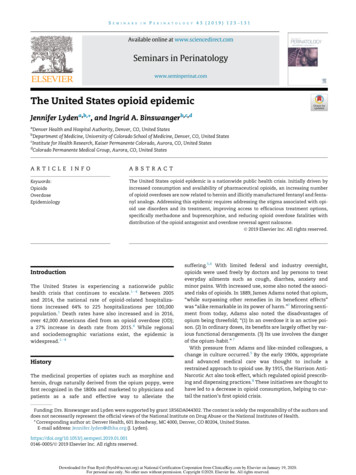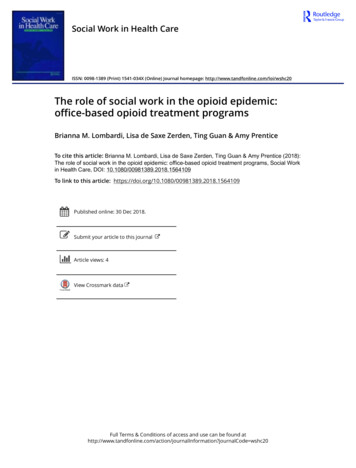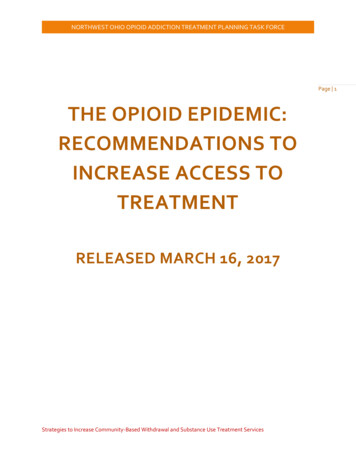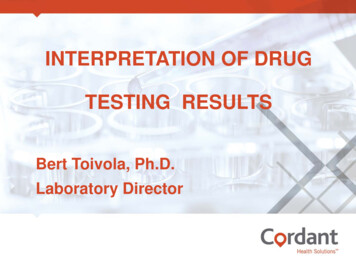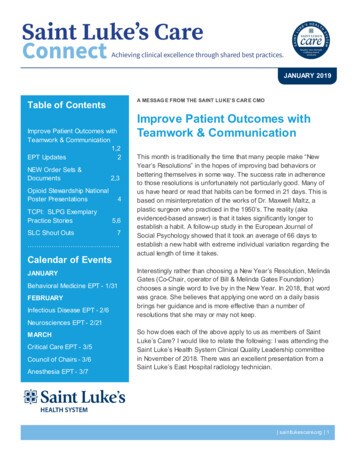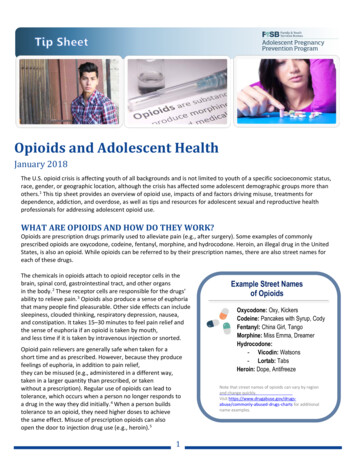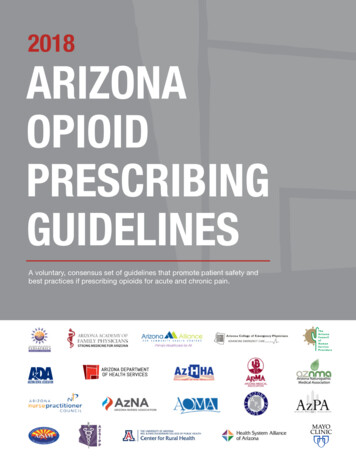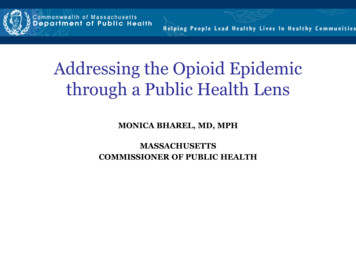
Transcription
Addressing the Opioid Epidemicthrough a Public Health LensMONICA BHAREL, MD, MPHMASSACHUSETTSCOMMISSIONER OF PUBLIC HEALTH
VISIONOptimal health and well-being for all people inMassachusetts, supported by a strong publichealth infrastructure and healthcare delivery.MISSIONThe mission of the Massachusetts Department of Public Health (DPH) is to prevent illness, injury, andpremature death; to ensure access to high quality public health and health care services; and topromote wellness and health equity for all people in the Commonwealth.DATADETERMINANTSDISPARITIESWe provide relevant, timelyaccess to data for DPH,researchers, press and thegeneral public in aneffective manner in order totarget disparities andimpact outcomes.We focus on the socialdeterminants of health - theconditions in which peopleare born, grow, live, workand age, which contributeto health inequities.We consistently recognizeand strive to eliminatehealth disparities amongstpopulations inMassachusetts, whereverthey may exist.EVERYDAY EXCELLENCEPASSION AND INNOVATIONINCLUSIVENESS AND COLLABORATION
The range of DPHPrevention and Wellness – Health Access – Nutrition – Perinatal and EarlyChildhood – Adult Treatment – Data Analytics and Support – Housing andHomelessness – Violence and Injury Prevention – Office of Statistics andEvaluation – Childhood Lead Poisoning Prevention – Community Sanitation –Drug Control – Occupational Health Surveillance – PWTF – SANE Program –Interagency Initiatives – Planning and Development – Prevention – ProblemGaming – Quality Assurance and Licensing – Youth and Young Adults – EarlyIntervention – Children and Youth with Special Needs – EpidemiologyProgram – Immunization Program – Global Populations and Infectious DiseasePrevention – STI Prevention – HIV/AIDS – Integrated Surveillance andInformatics Services – Clinical Microbiology Lab – Chemical Threat,Environment and Chemistry Lab – Childhood Lead Screening – EnvironmentalMicrobiology and Molecular Foodborne Lab – STD/HIV Laboratories –Biological Threat Response Lab – Central Services and Informatics – QualityAssurance – Safety and Training – Health Care Certification and Licensure –Health Professional Licensure – Office of Emergency Medical Services – DoN –Medical Use of Marijuana – Shattuck Hospital – Mass Hospital School –Tewksbury Hospital – Western MA Hospital – State Office of Pharmacy Services– Office of Local and Regional Health – Office of Health Equity – Accreditationand Performance Management – ODMOA – OPEM – HR and Diversity – Officeof General Counsel – Office of CFO – Commissioner’s Office
300 DATASETSDIFFERENTLANGUAGES
Massachusetts Departmentof Public HealthMassachusetts DPH will be anational leader in innovative,outcomes-focused public health based on adata-driven approach, with a focus onquality public health and health careservices and anemphasis on the social determinants anderadication of health care disparities.
The opioid epidemicburden in Massachusetts57% associated with fentanyl
The opioid epidemicburden in MassachusettsUnintentional Opioid Deaths by GenderUnintentional Opioid Deaths by Age
The opioid epidemicburden in Massachusetts1 Unintentional poisoning/overdose deaths combine unintentional and undetermined intents to account for a change in death coding that occurred in2005. Suicides are excluded from this analysis
Governor Baker’sOpioid Working GroupPrevention Intervention Treatment Recovery
Progress To-Date Adding over 200 new treatment beds across the state; Working to redesign, redevelop and relaunch the Prescription Monitoring Program (PMP) online system; Passing legislation requiring pharmacists to enter data into the PMP within one business day (24 hours), downfrom 7 days of receipt of prescription; Establishment of a cross-institutional agreement by the Commonwealth’s four medical schools and theMassachusetts Medical Society in developing a first-in-the-nation, cross-institutional set of core competenciesthat will be incorporated in all of the medical school’s curriculum for medical students, ensuring critical andnecessary best practices for prescription drug use and management are taught; Establishment of a cross-institutional agreement by the Commonwealth’s three dental medicine schools andthe Massachusetts Dental Society mirroring the medical schools in developing a cross-institutional set of corecompetencies; Holding Drug Take-Back Day at 133 sites across the Commonwealth to collect unused prescription drugs for safedisposal; Convening of the state’s Drug Formulary Commission; Reinforcing the requirement that all DPH licensed addiction treatment programs must accept patients who areon methadone or buprenorphine medication; Planning for the transfer of women civilly committed under Section 35 at MCI Framingham to Taunton StateHospital by Spring 2016; Issuance of Division of Insurance guidelines to commercial insurers on the implementation of the substance usedisorder recovery law (Chapter 258) which requires insurers to cover the cost of medically necessary clinicalstabilization services for up to 14 days without prior authorization; Improving the affordability of naloxone for all 351 Massachusetts communities through a state bulk purchasingarrangement; Strengthening the state’s commitment to residential recovery programs through rate increases
Governor Baker’sOpioid Working GroupPrevention Intervention Treatment Recovery
Governor Baker’sOpioid Working GroupPrevention Intervention Treatment Recovery
#State Without StigMAHELPLINE1-800-327-5050
Survey: reason forprescription painkiller misuseToo easy to buy prescription painkillersillegallyPainkillers are prescribed too often or indoses that are bigger than necessaryToo easy to get painkillers from those whosave pills58%50%47%Source: Boston Globe and Harvard T.H. Chan School of Public Health,Prescription Painkiller Abuse: Attitudes among Adults inMassachusetts and the United States
Medical Core Competencies:Primary Prevention Domain Preventing Prescription Drug Misuse:Screening, Evaluation, and Prevention1. Evaluate a patient’s pain using age, gender, and culturally appropriate evidence-basedmethodologies.2. Evaluate a patient’s risk for substance use disorders by utilizing age, gender, and culturallyappropriate evidence-based communication skills and assessment methodologies,supplemented with relevant available patient information, including but not limited tohealth records, family history, prescription dispensing records (e.g. the Prescription DrugMonitoring Program or “PMP”), drug urine screenings, and screenings for commonly cooccurring psychiatric disorders (especially depression, anxiety disorders, and PTSD).3. Identify and describe potential pharmacological and non-pharmacological treatmentoptions including opioid and non-opioid pharmacological treatments for acute andchronic pain management, along with patient communication and education regardingthe risks and benefits associated with each of these available treatment options.
Medical Core Competencies:Secondary Prevention Domain Treating Patients At-Risk for Substance Use Disorders: EngagePatients in Safe, Informed, and Patient-Centered TreatmentPlanning4. Describe substance use disorder treatment options, including medication-assistedtreatment, as well as demonstrate the ability to appropriately refer patients to addictionmedicine specialists and treatment programs for both relapse prevention and cooccurring psychiatric disorders.5. Prepare evidence-based and patient-centered pain management and substance usedisorder treatment plans for patients with acute and chronic pain with special attentionto safe prescribing and recognizing patients displaying signs of aberrant prescription usebehaviors.6. Demonstrate the foundational skills in patient-centered counselling and behavior changein the context of a patient encounter, consistent with evidence-based techniques.
Medical Core Competencies:Tertiary Prevention Domain Managing Substance Use Disorders as a Chronic Disease:Eliminate Stigma and Build Awareness of Social Determinants7. Recognize the risk factors for, and signs of, opioid overdose and demonstrate the correctuse of naloxone rescue.8. Recognize substance use disorders as a chronic disease by effectively applying a chronicdisease model in the ongoing assessment and management of the patient.9. Recognize their own and societal stigmatization and biases against individuals withsubstance use disorders and associated evidence-based medication-assisted treatment.10. Identify and incorporate relevant data regarding social determinants of health intotreatment planning for substance use disorders.
Governor Baker’sOpioid Working GroupPrevention Intervention Treatment Recovery
Governor Baker’sOpioid Working GroupPrevention Intervention Treatment Recovery
Quantity ofPrescriptions AnnuallyThis table includes all Schedule II and III opioid prescriptionsdispensed and reported to the MA Online PMP, for both in- andout-of-state residents.
Quantity ofPrescriptions AnnuallyMA Prescription Monitoring Program County-Level Data (Q1 2016)
Reversing an Overdose: Use ofNaloxone
Three Key Stakeholdersin Naloxone ExpansionBystandersFirst RespondersPharmacies/Prescribers23
Bystander program model One statewide medical director who authorizes the training anddistribution under a standing order. The naloxone is purchased by the DPH State Office of Pharmacy Serviceswith funds from the DPH Bureau of Substance Abuse Services under theMedical Director’s license. Programs receive naloxone and atomizers from DPH BSAS program. Assemble kits, and then train/distribute. Full kit is two doses, two nasal atomization delivery devices, andinstructions for use. Training includes how to reduce risk and prevent an overdose, recognizesigns of an overdose, access emergency medical services, and administerintra-nasal naloxone. Bystanders are instructed to deliver naloxone when opioid overdose occursin addition to other prevention/intervention. After being trained, eachparticipant receives a naloxone kit.24
Three Key Stakeholdersin Naloxone ExpansionBystandersFirst RespondersPharmacies/Prescribers25
First responders model In emergency situations, historically only paramedics haveadministered naloxone via injection in the event of an overdose. 2005, the Boston EMS applied for a Special Project Waiver from theDPH Office of Emergency Medical Services (OEMS)– allow EMT’s to administer naloxone via intra-nasal spray.– first use of intra-nasal administered naloxone in Massachusetts. 2010 DPH began a pilot program to equip First Responders withintra-nasal naloxone. 2014 regulations amended to allow first responders to carrynaloxone with medical director oversight26
First responders In the FY2015 budget, 1,000,000 for first responder andbystander naloxone programs funded 37 police or firedepartments in 23 municipalities to implement first respondernaloxone administration. Police and Fire Departments work with local hospitals or othermedical directors for the medical control of their naloxoneadministration. In FY2016, Governor Baker filed to create a naloxone municipalbulk purchase trust fund, expanding availability of naloxone inMassachusetts.27
Three Key Stakeholdersin Naloxone ExpansionBystandersFirst RespondersPharmacies/Prescribers28
Pharmacies and prescribers model Historically, writing a prescription for naloxone to a person at risk of anoverdose not common clinical practice and pharmacies were not equippedto fill prescriptions for naloxone. Some inpatients, emergency departments, health centers developedstanding orders for hospital pharmacies to furnish naloxone on discharge 2014: DPH regulation change to permit standing order narcan in pharmacies– Allow pharmacists to establish a standing order with a prescriber fordispensing naloxone rescue kits. MassHealth and other insurers cover prescriptions for naloxone. When a pharmacy has an established standing order for naloxone,customers do not need a prescription to be dispensed a naloxone rescuekit. The customer’s insurance will be billed and a co-pay or full price will becharged depending on the insurance coverage.29
Other HighlightedIntervention Progress to date Redesigning, redeveloping and relaunching the PrescriptionMonitoring Program (PMP) online system; Passing legislation requiring pharmacists to enter data into thePMP within one business day (24 hours), down from 7 days ofreceipt of prescription; Holding Drug Take-Back Day at 133 sites to collect unusedprescription drugs for safe disposal; Convening of the state’s Drug Formulary Commission;
Governor Baker’sOpioid Working GroupPrevention Intervention Treatment Recovery
Governor Baker’sOpioid Working GroupPrevention Intervention Treatment Recovery
Treatment and Recovery:Progress To-Date Adding over 200 new treatment beds across the state; Planning for the transfer of women civilly committed under Section35 at MCI Framingham to Taunton State Hospital by Spring 2016; Reinforcing the requirement that all DPH licensed addictiontreatment programs must accept patients who are on methadone orbuprenorphine medication; Strengthening the state’s commitment to residential recoveryprograms through rate increases. Issuance of Division of Insurance guidelines to commercial insurerson the implementation of the substance use disorder recovery law(Chapter 258) which requires insurers to cover the cost of medicallynecessary clinical stabilization services for up to 14 days withoutprior authorization;
Substance Use, Treatment, Educationand Prevention Law (STEP)Ch. 52 of the Acts of 2016 7 day limit on a first time opioid prescription; allows for apharmacist partial fill Patient voluntary non-opioid directive (12/16) Allows the Municipal Police Training Committee to establish acourse within the recruit basic training curriculum to trainofficers on response to calls for assistance on drug relatedoverdoses Amends the Civil Liberties law so that any person whoadministers naloxone is not liable for injuries resulting from theinjection Requires substance abuse evaluation in ED when present for anOD (start 7/16)
Addressing the Opioid epidemicthrough a Public Health LensMONICA BHAREL, MD, MPHMASSACHUSETTSCOMMISSIONER OF PUBLIC HEALTH
MassHealth and other insurers cover prescriptions for naloxone. When a pharmacy has an established standing order for naloxone, customers do not need a prescription to be dispensed a naloxone rescue kit. The customer's insurance will be billed and a co-pay or full price will be charged depending on the insurance coverage. 29


